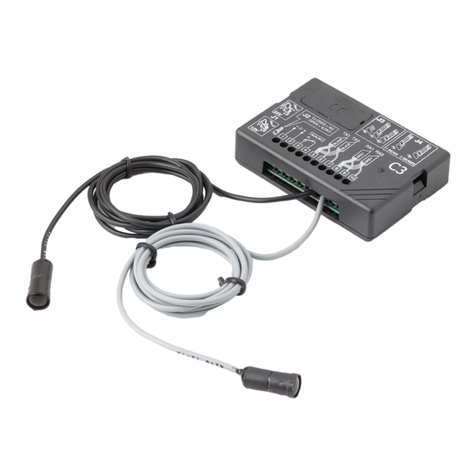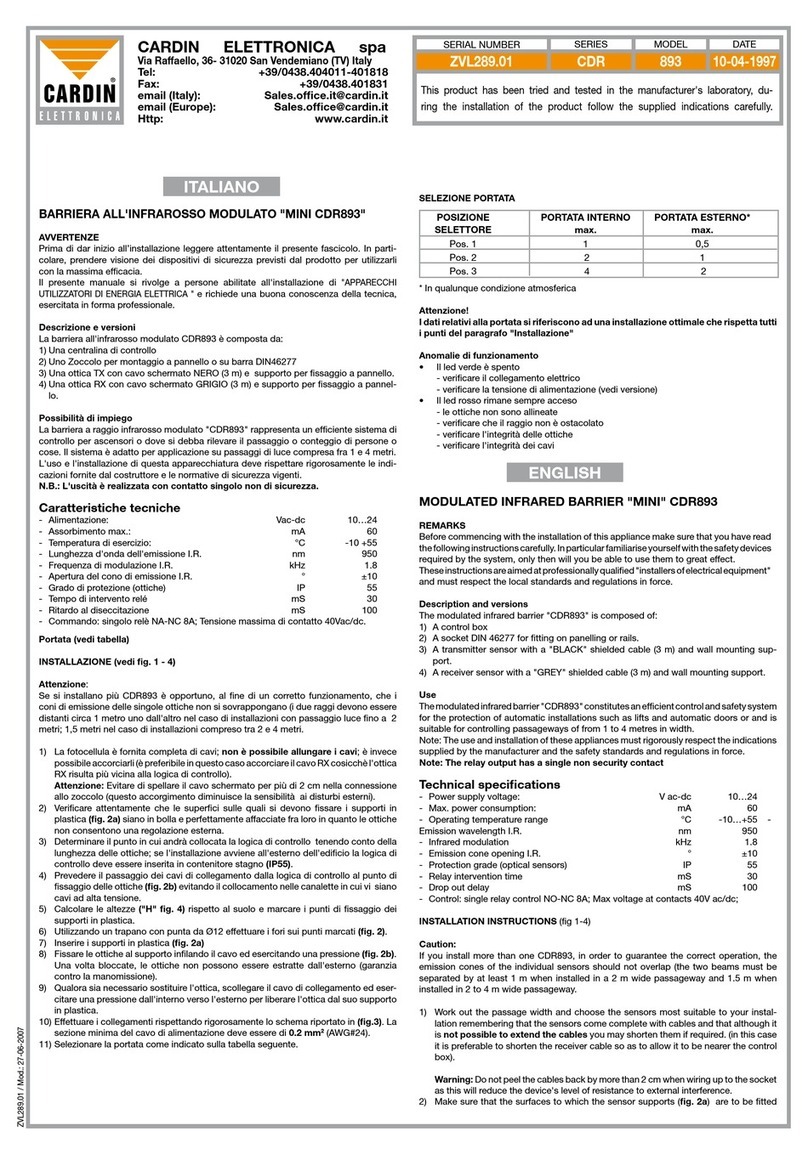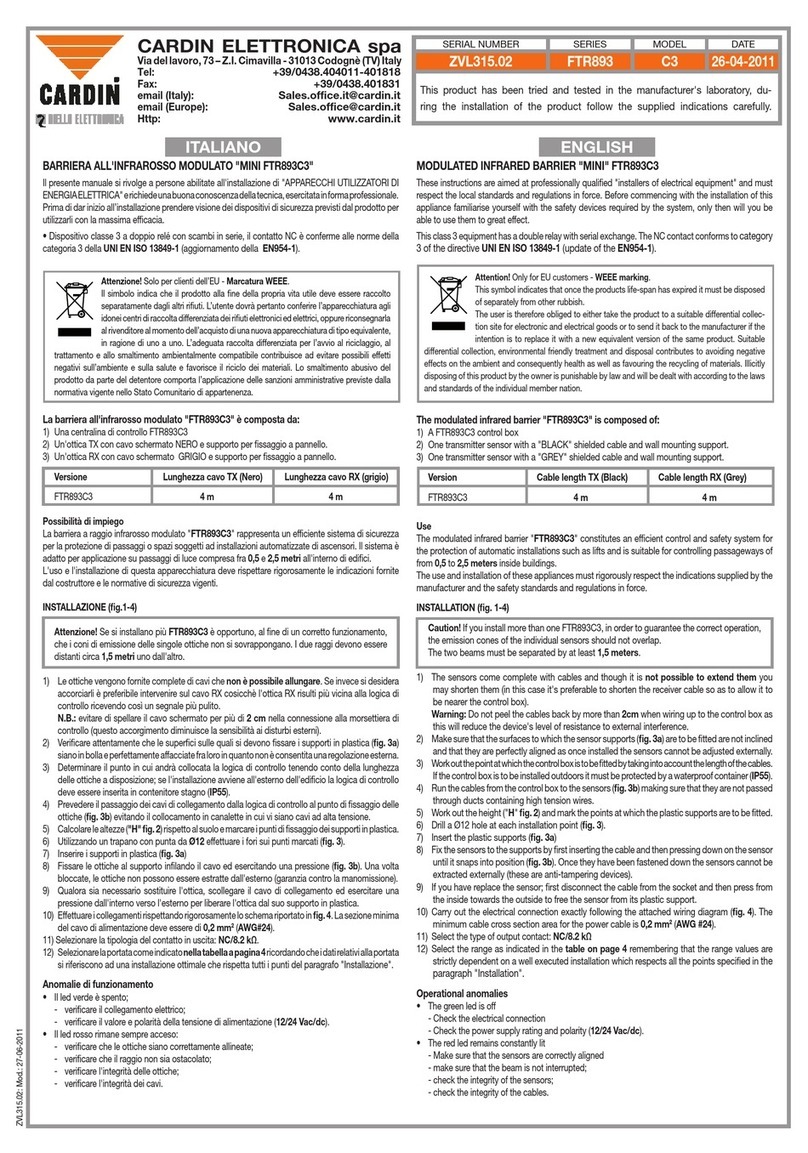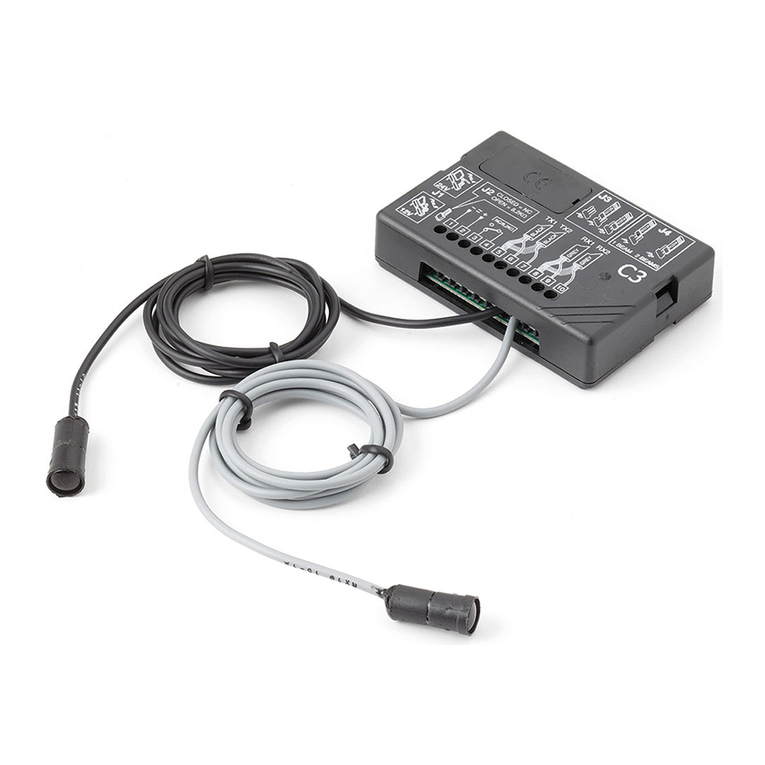
Innesto scheda espansione fotocellule
CDR871/2
17-06-94
DM0314 Description :
Product Code :
Date :
Drawing number :
P.J.Heath
CARDIN ELETTRONICA S.p.A - 31020 San Vendemiano (TV) Italy - via Raffaello, 36 Tel: 0438/401818 Fax: 0438/401831
Draft :
All rights reserved. Unauthorised copying or use of the information contained in this document is punishable by law
CDR871/872
Min. 65mm
max.10mm.
Fissaggio placca inferiore
CDR871/2
17-06-94
DM0009 Description :
Product Code :
Date :
Drawing number :
P.J.Heath
CARDIN ELETTRONICA S.p.A - 31020 San Vendemiano (TV) Italy - via Raffaello, 36 Tel: 0438/401818 Fax: 0438/401831
Draft :
All rights reserved. Unauthorised copying or use of the information contained in this document is punishable by law
CDR871/872
FRANÇAIS
Attention! Seulement pour les clients de l'EU - Marquage WEEE.
Ce symbole indique l’obligation de ne pas éliminer l’appareil, à la fin de
sa durée de vie, avec les déchets municipaux non triés et de procéder à
sa collecte sélective. Par conséquent, l’utilisateur doit remettre l’appareil
à un centre de collecte sélective des déchets électroniques et électriques
ou au revendeur qui est tenu, lorsqu’il fournit un nouvel appareil, de faire
en sorte que les déchets puissent lui être remis, sur une base de un pour
un, pour autant que l’appareil soit de type équivalent à celui qu’il fournit.
La collecte sélective des équipements électriques et électroniques en vue de leur
valorisation, leur traitement et leur élimination dans le respect de l’environnement
contribue à éviter la nocivité desdits équipements pour l’environnement et pour
la santé et à encourager leur recyclage. L’élimination abusive de l’équipement de
la part du détenteur final comporte l’application des sanctions administratives
prévues par les normes en vigueur dans l’État Membre d’appartenance.
Description
Barrière multiplexée à l'infrarouge composée d'un émetteur et d'un récepteur de
base, tous les deux étant extensibles par l'adjonction jusqu'à trois modules d'ex-
tension. Les appareils de base sont logés dans un boîtier étanche composé d'un
module en aluminium extrudé d'une longueur de 53 cm, d'un écran en plastique
antichoc et de deux bouchons de fermeture. La longueur du boîtier recevant le
module d'extension est de 50 cm et ses caractéristiques sont identiques à celles
de la base. Le boîtier est prédisposé pour être fixé au mur; les plaques de fixation,
deux pour les modules de base et une pour les extensions, insérées directement
lors de la phase d'extrusion, en facilitent le montage. Chaque module, aussi bien
TX que RX, est doté de 4 - 8 étages infrarouges. Une extension maximum permet
au système de mettre en œuvre 32 rayons, ce qui permet de couvrir une hauteur
maxi. de 203 cm (avec les 3extensions insérées).
Applications possibles
La barrière multiplexée est un système de sécurité et de contrôle efficace, destiné à
assurer la sécurité sur des passages ou des sites avec automatismes, tels que portes
automatisées, sas, etc., ainsi que la détection et le contrôle sur tous passages, portes
cochères et passages piétons se trouvant à l'intérieur ou à l'extérieur d'édifices. Elle
est adaptée aux passages d'une largeur de 10 à 18 m (à l'intérieur) en fonction de
la version appliquée. L'alimentation prévue est de 12 Vac/dc. Pour une application
sur systèmes disposant de 24 Vac, il est nécessaire d'utiliser un transformateur,
disponible sur demande. Pour l'utilisation et l'installation de ces appareils, se confor-
mer impérativement aux instructions du Constructeur et aux normes de sécurité en
vigueur. Le Constructeur ne peut en aucun cas être tenu responsable de dommages
éventuels dérivant d'utilisations impropres, erronées ou illogiques.
Versions:
CDR 871 comprend:
- 1 émetteur de base sous boîtier d'une longueur de 530 mm et d'une portée maxi.
de 10 m, un jeu de vis et 1 microfusible de réserve;
- 1 récepteur de base sous boîtier d'une longueur de 530 mm et d'une portée maxi.
de 10 m et un jeu de vis.
CDR 872 comprend:
- 1 émetteur de base sous boîtier d'une longueur de 530 mm et d'une portée maxi.
de 18 m, un jeu de vis et 1 microfusible de réserve;
- 1 récepteur de base sous boîtier d'une longueur de 530 mm et d'une portée maxi.
de 18 m et un jeu de vis.
Extension en option
•Moduled'extensionémetteurd'unelongueurde500 mm et d'une portée maxi.
de 10 ou 18 m en fonction de la version.
•Moduled'extensionrécepteurd'unelongueurde500 mm et d'une portée maxi.
de 10 ou 18 m en fonction de la version.
INSTALLATION
Déterminer la largeur et la hauteur du passage à couvrir (voir fig. 1). Choisir ensuite
le modèle plus approprié et le nombre d'extensions qui s'impose. Se rappeler qu'un
module de base peut couvrir un espace d'une hauteur de 53 cm et que chaque
module d'extension couvre un espace de 50 cm.
Exemple d'installation (environnement intérieur)
L'installation illustrée en fig.1 requiert l'application du système CDR871:
1 module de base (TX-RX)
2 modules d'extension (TX-RX).
NOTICE DE MONTAGE (fig. 2-3)
Attention !
Lecircuitne pourra êtremissous tension qu'après avoir monté toutes lesparties
du système, y compris les modules d'extension.
1) Contrôlerque les surfaces quireçoiventle support
soient à niveau et parfaitement alignées l'une
par rapport à l'autre.
2) Détermineren bas l'endroit(min.65mmentre
l'entraxe des trous et le sol) où seront fixées
les deux plaques de support inférieures
(TX-RX de base) et contrôler leur alignement
vertical. Prédisposer cet endroit pour les
branchements électriques (fig. 2).
3) En se servant uniquement des modules de
base TX-RX branchés provisoirement (bran-
chement non fixe), effectuer le centrage (voir
paragraphe "Centrage du système"). Cette opéra-
tion permet d'établir exactement la position que les deux
modules de base doivent avoir, l'un par rapport à l'autre, dans le système.
Attention: à ce point, avant de continuer le montage, mettre les modules hors
tension.
4) Percer les trous pour le fixage et fixer la plaque inférieure au mur à l'aide des
vis et des chevilles fournies en dotation. Si l'on ne prévoit pas l'application des
modules d'extension, fixer la plaque supérieure de telle façon qu'elle se trouve
côte à côte avec le côté supérieur du module en aluminium.
5) Retirer l'écran en plastique et faire coulisser le module sur la plaque inférieure.
Extraire à moitié la plaque supérieure, percer les trous et la fixer au mur.
6) Bloquer le bas du module en aluminium en vissant la vis sans tête de fixation
jusqu'au moment de son contact avec la plaque de support.
7) Insérerlemodule d'extension intermédiaire(voirfig.3).
Contrôlerqueles deux connecteurs s'embrochent
parfaitement. Après quoi, extraire le module,
régler si nécessaire la plaque supérieure "B"
et la fixer solidement au mur.
8) Bloquer le haut des modules en aluminium
en vissant les vis sans tête de fixation (en se
servant d'une clef à six pans "A") jusqu'au
moment de leur contact avec les plaques
de support.
9) Effectuer les branchements électriques sur
le bornier de branchement de la carte de base
(voir paragraphe relatif).
10) Fixer les circuits aux supports en aluminium en vis-
sant soigneusement toutes les vis des circuits imprimés.
La vis devra être vissée jusqu'au moment du contact de sa tête avec la
plaquette étamée correspondante (ne pas forcer).
N.B.: ce système garantit une protection efficace du circuit contre
les perturbations extérieures.
11) Répéter les opérations de la 7ème à la 10ème étape pour chaque module d'ex-
tension.
12) Effectuer tous les réglages (voir paragraphe relatif), insérer par encliquetage les
bouchons de fermeture inférieur et supérieur (voir vue d'ensemble fig. 6p), ainsi
que l'écran en plastique.
N.B.: si le système doit couvrir toute la largeur du passage, pour l'application du
dernier module d'extension, procéder de la façon suivante:
•Installerlabaseetlesextensionsintermédiaires;
•Fixerlaplaquesupérieure"A" à la hauteur prévue (voir 4a);
• Tournerlaplaquede90°,insérerlemoduleterminaletlereportersur
l'axe du système (fig. 4a-4b);
•L'insérersurlaplaqueintermédiaire(g.4c)etprocéderaublocage.
Exemple de montage
Fissaggio modulotrrminali
CDR871
17-06-94
DM0014 Description :
Product Code :
Date :
Drawing number :
P.J.Heath
CARDIN ELETTRONICA S.p.A - 31020 San Vendemiano (TV) Italy - via Raffaello, 36 Tel: 0438/401818 Fax: 0438/401831
Draft :
All rights reserved. Unauthorised copying or use of the information contained in this document is punishable by law
492,5 mm
A
B
170 cm
8 m
base = 53 cm expansion = 50 cm expansion = 50 cm
Esempio d'installazione barriere multiplex
CDR871
10-06-94
DI0003 Description :
Product Code :
Date :
Drawing number :
P.J.Heath
CARDIN ELETTRONICA S.p.A - 31020 San Vendemiano (TV) Italy - via Raffaello, 36 Tel: 0438/401818 Fax: 0438/401831
Draft :
All rights reserved. Unauthorised copying or use of the information contained in this document is punishable by law
CDR871-872
3
2
1
4c
4a 4b
7

































